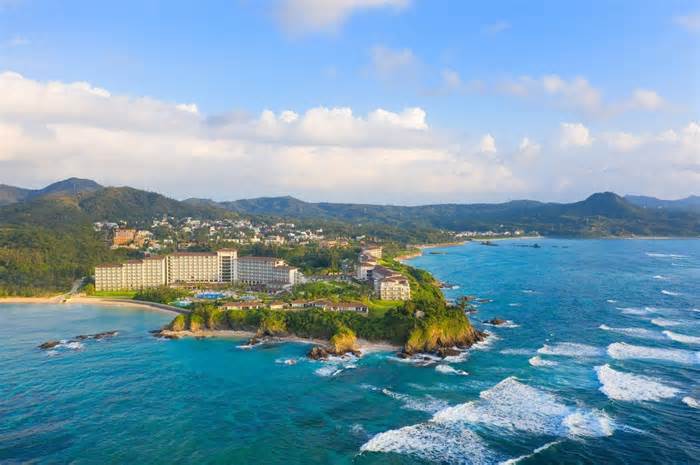Okinawa, known for the wealth of its varied islands, offers visitors a tropical climate, extensive beaches and coral reefs. Home to World War II sites and a distinct “Blue Zone” culinary culture, Okinawa has long been a secret place. Getaway for locals and a refreshing option for Japan’s busiest spots like Tokyo, Kyoto and Osaka. Okinawa is now in a position to be discovered by the rest of the world.
April and October fall within the spring and autumn seasons, providing pleasant weather conditions that are ideal for exploring the picturesque island. In April you can enjoy pleasant temperatures, ideal for activities and tourist visits. However, each month has its own special appeal. Unlike the Somei Yoshino cherry trees of mainland Japan, Okinawa’s Hikanzakura flowers have deeper shades of pink with bell-shaped petals that bloom downward, a contrast to the “basic” Sakura seen in overcrowded places on the mainland. like Tokyo. In Okinawa, the 2025 season runs from January to early February and promises picturesque festival displays, Hanami (cherry blossom viewing picnics), tea ceremonies and fewer crowds.
“We’ve seen notable demand for Japan in 2024, with 150% year-on-year growth, and that enthusiasm will only increase this year,” says Tom Marchant, co-founder of Black TomatoArray, a luxury tour operator. “More travelers are looking beyond the same old places like Tokyo, Kyoto and Osaka, and Okinawa is emerging as a destination notable for its beautiful beaches and rare wildlife. It’s especially wonderful for families, with luxury hotels like Rosewood Miyakojima opening this year with amenities like the Explorer’s Kids Club.
Marchant adds, “Okinawa offers countless experiences that are ideal for those that enjoy the outdoors. Think snorkeling on Zamami Island, kayaking through Yanbaru’s mangrove forest waterways and jungle canyoning in Iriomote Island. As one of the world’s five Blue Zones, there’s also a real draw for travelers wanting to engage with Okinawa’s rich traditions and lifestyle, which is why we’re offering a Blue Zone Cooking Class in our new itinerary. It’s a chance to try local ingredients like goya and umi budo (sea grapes) and experience the secrets to Okinawan longevity firsthand.”
Okinawa Prefecture is one of the 47 prefectures of Japan. It comprises more than 160 inhabited and uninhabited islands, with a combined area of over 2,000 square kilometers. The population is around 1.4 million. The islands of Okinawa are as diverse as they are plentiful, stretching from the main island in the north to Ishigaki and beyond in the south. Authentic Okinawan experiences await, with cultural treasures, outdoor adventure and world-class diving just some of the draws. You can fly to Okinawa from Tokyo, Osaka, China, South Korea, Singapore, Taiwan or Hong Kong. You can also take a monorail from Naha Airport to Shuri.
Guests enjoy stunning views.
Forbes Travel Guide The Halekulani Okinawa Five-Star Double Hotel is the best base for travelers to take advantage of its prime location. The hotel has presented its Heavenly Tent Sauna, an ideal restorative pleasure to welcome the new year. The experience will pay tribute to the rejuvenating art of totonou, a Japanese verb meaning “to fix” or “to adapt. ” In the context of saunas (on the rise in Japan), it refers to a state in which the body and brain find balance, allowing rest and tranquility.
Onna no Eki Nakayukui Market – Okinawan food market offering local delicacies, nuts and vegetables and other Okinawan products. Opened in 2004, this direct sales center offers a wide variety of agricultural and processed products from Onna Village and is characterized by its food stalls in front of the parking lot, where visitors can enjoy a variety of snacks and delicacies, such as sata andagi (Okinawa fritters). ).
Yomitan Village Yachimun no Sato: A pottery village with several artisan workshops to practice and buy products. The island’s pottery production base was moved from Tsuboya in Naha to the village of Yomitan in the late 1970s, when Yuntanza Gama (a kiln in Yomitan) was founded. built for the first time. Shinman Yamada is part of an organization of ceramic artists who created the kiln, emphasizing the need for a giant stepped kiln to create quality ceramic pieces.
Naha City Tour: Top places to visit: Tsuboya Pottery Street, Makishi Public Market and Shuri Castle.
Spiritual sites: Seifa Utaki, Yahara Zukasa, Kakinohana Daughter and Tamagusuku Gusuku
Lunch at Garamanjaku – Authentic and nostalgic Okinawan cuisine, serving seasonal local Okinawan vegetables and medicinal plants. Traditional Okinawan staples come with Kandaba (yam leaf), homemade miso with over 40 ingredients including Asa, Mozuku and Hijiki. A meal with more than 50 types of medicinal plants.
One Community. Many Voices. Create a free account to share your thoughts.
Our network aims to connect others through open and thoughtful conversations. We need our readers to share their perspectives and exchange concepts and facts in one space.
To do this, please comply with the posting regulations in our site’s terms of use. We summarize some of those key regulations below. In short, civilized.
Your message will be rejected if we notice that it appears to contain:
User accounts will be blocked if we notice or believe that users are engaged in:
So how can you be a user?
Thanks for reading our community guidelines. Please read the full list of posting rules found in our site’s Terms of Service.

